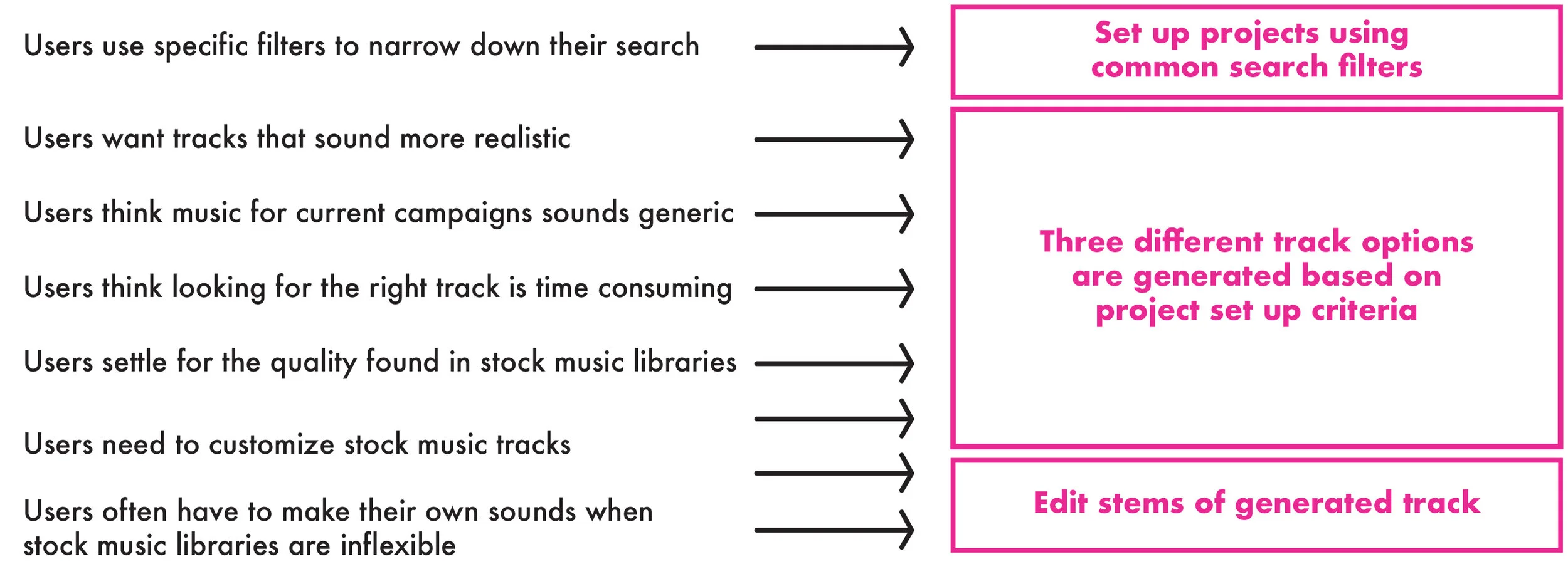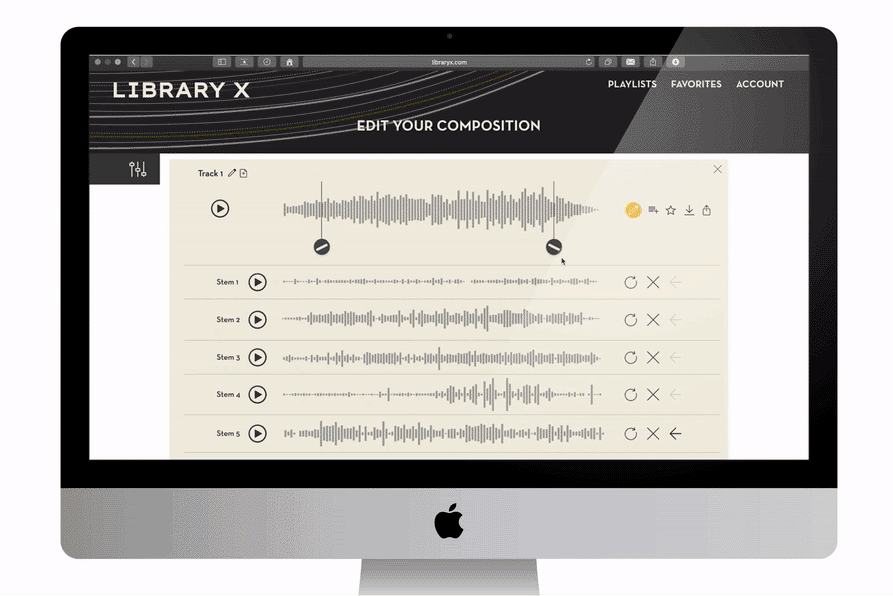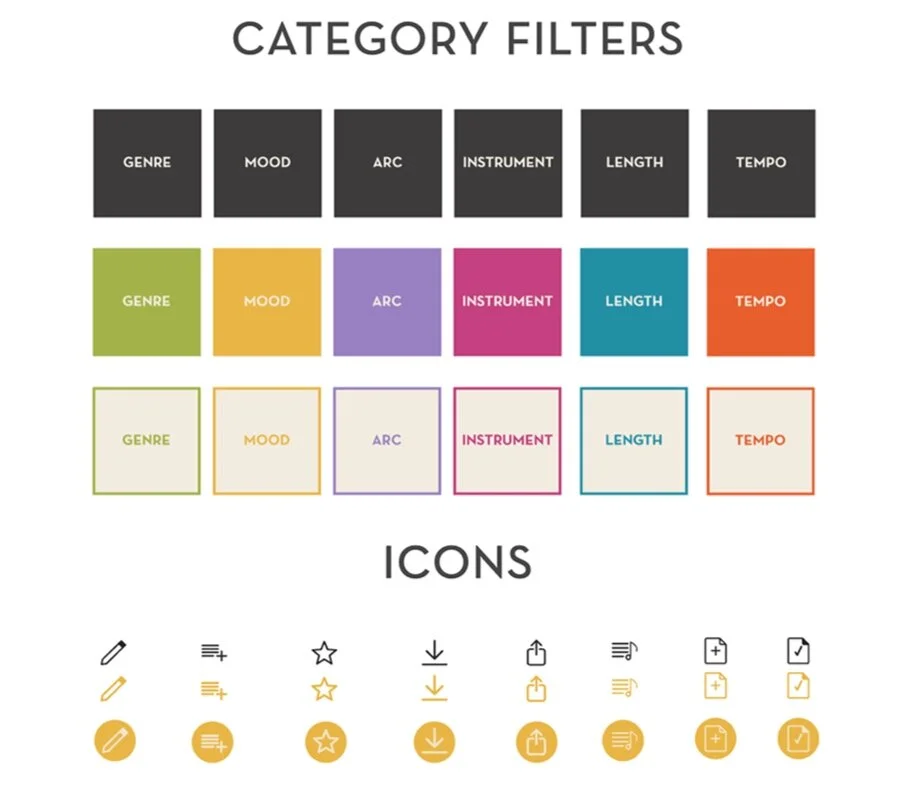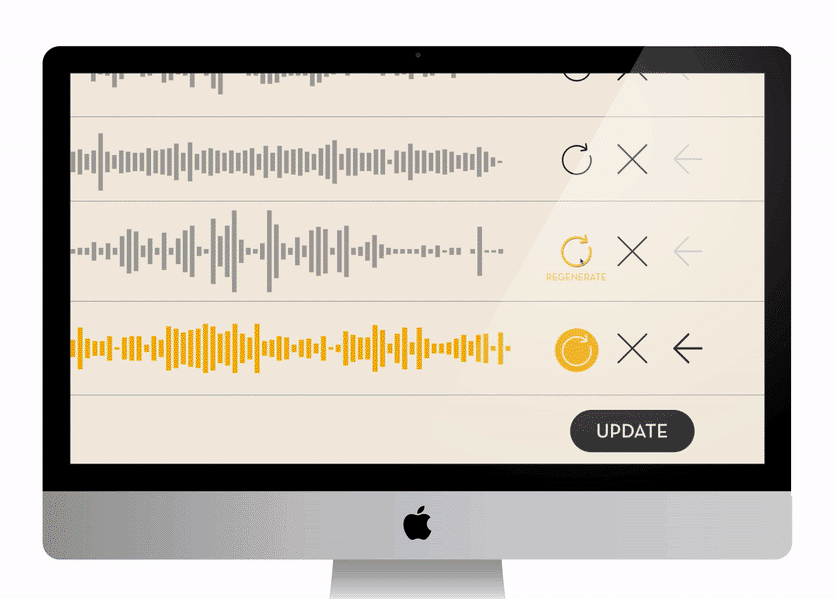LIBRARY X
A Creative Collaboration Between Man and Machine
UX Research | UX Design | UI Design
Isabela Quiambao | Lead Researcher Jen Shin | Project Manager
My role | Lead Designer
Library X, is a new platform designed to disrupt the existing stock music library market. Through use of AI generated music based on simple user-inputed filters, even non-musically proficient professionals will be able to compose and edit the generated tracks to sound like a composer was hired for their project.
OPPORTUNITY
Currently, ad agency creatives currently turn to many different stock music libraries for music used in campaigns and ad spots when their budget doesn’t have the funds to hire a composer to create a custom track.
Searching through thousands of stock tracks often leaves creatives feeling frustrated at the lack of true-to-life sounds and flexibility within the tracks they find. Through analyzing the market and speaking with our client, we were able to distinguish the opportunity for Library X to offer users more creative freedom and flexibility within the site. Through use of the AI, the site can generate an original track that the user can then edit elements of to make it their own.
SCOPE OF WORK
Our team was tasked with designing an MVP of the interface for Library X’s backend, showcasing features that users both have a need for and would also find intuitive to use. Prior to beginning research, our client presented us with potential features that he was hoping to include within the MVP of Library X.
The ability to set up a project using familiar filters that users currently employ to narrow down their music search
The generation of 3 varied tracks based on criteria the user inputs
The ability to customize the generated tracks by removing or replacing stems
Changing the placement of the narrative arc in the tracks
Auditioning tracks to video
RESEARCH
Research Techniques: Business Analysis, Competitive Business Matrix, Competitive Feature Analysis, User Interviews, User Persona, Journey Map
The goal of our research was to understand how people currently use stock libraries, and learn of any objectives or frustrations users may have when searching for stock music. To this end, we spoke with seven professionals in the industry, ranging from video producers and editors to content creators to learn how they currently are using stock music libraries for their projects.
“Even if the song isn’t perfect, I’ll settle for it. Otherwise, I’ll spend two hours just searching.”
“If it’s too on the nose, it doesn’t feel authentic. [Music] should have an emotional connection.”
“Some tracks are easier to manipulate than others. I’ll download a track, think it’s perfect, but realize it doesn’t fit.”
“‘Pre-baked’ music is never going to be as good as composed. It lacks great personality for projects.”
To further understand our audience and empathize with our average user’s needs, we created a representation of Library X’s target users, utilizing our persona to inform our design choices moving forward.
Seth is an art director at a mid-sized ad agency who relies on stock music libraries for client projects, when his client’s budget lacks the funds to hire composers to write custom tracks for their spots.
SETH
35 | ART DIRECTOR | NEW YORK, NY
Pain Points:
Time consuming music searches
Uneditable stock music
Goals:
Deliver superior tracks within a budget
Find tracks that feel authentic + original
Needs:
To edit the stock music he finds
Descriptive filters to search
PROBLEM
Going through stock music libraries is time consuming due to the overabundance of music within each database. Often the music found within sounds computer generated and lacks originality, which further lengthens the time spent searching.
Seth often experiences choice paralysis when searching stock music libraries. He doesn’t have the time to search for perfect tracks within thousands, and is often frustrated by the limitations of stock music libraries.
How might we help Seth streamline his search for the perfect track while offering him more flexibility?
RESEARCH INSIGHTS
Based on our research, we were able to synthesize the data we collected through user interviews into categories that we used to validate the features proposed by our client for Library X.
DESIGN
Library X is a site backed by AI technology that utilizes simple category filters to generate multiple track compositions for the user to listen to, edit, and license for projects.
Currently users are searching for tracks using filters like genre and mood, and they prefer searching that way. We wanted to keep that aspect of the site familiar since the technology that Library X uses is so new.
Based on the user’s search criteria, the AI generates three completely original tracks that the user can edit within the site.
Users are able to edit the track in an edit bay, and regenerate elements of the track to make it their own. The site allows users to reclaim their creative license; they are no longer searching for music, they’re curating it!
We designed the face of Library X to have a sleek dark background to represent the site’s modern technological capabilities, and contrasted this with playful colors when the user hovers over icons and buttons to showcase our client’s values of maintaining the delight of working with music.
PROTOTYPE
Try me out!
TESTING
We validated Library X’s features and our design choices for the MVP in two separate rounds of testing with users who had prior experience working with stock music libraries. We first tested our mid-fidelity prototype, and then refined our design based on user feedback, before testing again.
We tested the users ability to intuitively complete the following tasks in both mid-fidelity and hi-fidelity rounds:
Gain access to the site + create an account
Compose a track based on a brief
Expand the track to look at the elements + replace the fifth element
Refresh the track
Edit the placement of the decent of the song and refresh the track
Add the track to a project playlist
Share the playlist with a coworker
In the Mid-Fidelity usability tests, both the expand and replace task as well as editing the placement of the decent in the song had the lowest success rate, so we focused on ideating on these when moving into Hi-Fidelity.
Mid-Fidelity
Hi-Fidelity
For the expand and replace task in the Mid-Fidelity usability tests, we saw that users were confused by the “Regenerate” icon, and weren’t sure when the stem had been updated.
In our Hi-Fidelity usability tests, when replacing a stem, users stated that the “replace” icon we used resembled a different symbol for musicians, so they were hesitant to click the correct icon.
Mid-Fidelity
Hi-Fidelity
In mid-fidelity testing, users didn’t seem to know that the toggles for the arc scrubber could be dragged due to lack of clickable cues in the prototype.
In our hi-fidelity prototype, we added a hover state that indicated to the user that the toggle could be dragged to the place of their choosing, which matched users expectations of a scrubber. This increased user performance by 20%.
TAKEAWAYS:
Over 80% of users were able to complete the tasks successfully in the hi-fidelity round of testing
User’s experience and results improved with clickable visual cues
MVP features are useful and wanted within the site
FURTHER DESIGN ADDITIONS
Based on the second round of testing, we iterated on our design further based on user feedback to ensure that the features of the MVP would be easier for users to employ; adding hover states, an onboarding how-to for the Edit Bay, and the ability for users to add notes to their tracks and playlists.
We added hover states with text that will populate under the icons to make sure that users knew what they were clicking into.
Library X would benefit from an onboarding guide for new users to learn how to edit tracks within the site. With the addition of an onboarding, users will feel more at ease when starting to generate and edit new tracks.
We also considered added a notes section to each track and playlist. This feature can be used for everything ranging from contents of the brief to track version edits.
LOOKING AHEAD
Since Library X is a new platform, each performance indicator is integral to tracking the site’s success. We propose tracking account sign ups, the number of friend referrals, tracks downloaded, playlists shared, and most importantly, the amount of music licenses purchased.
We suggest that there be a third round of A/B usability testing before moving into the beta version of Library X, using a few different icons to represent the “regenerate” button to determine which is most intuitive for users.
Through the launch of the beta version Library X, we’re excited for both non-musical professionals and those who are knowledgeable to be able to compose exciting and original tracks without having to spend thousands of dollars on composers or licensing deals with rock stars.
















